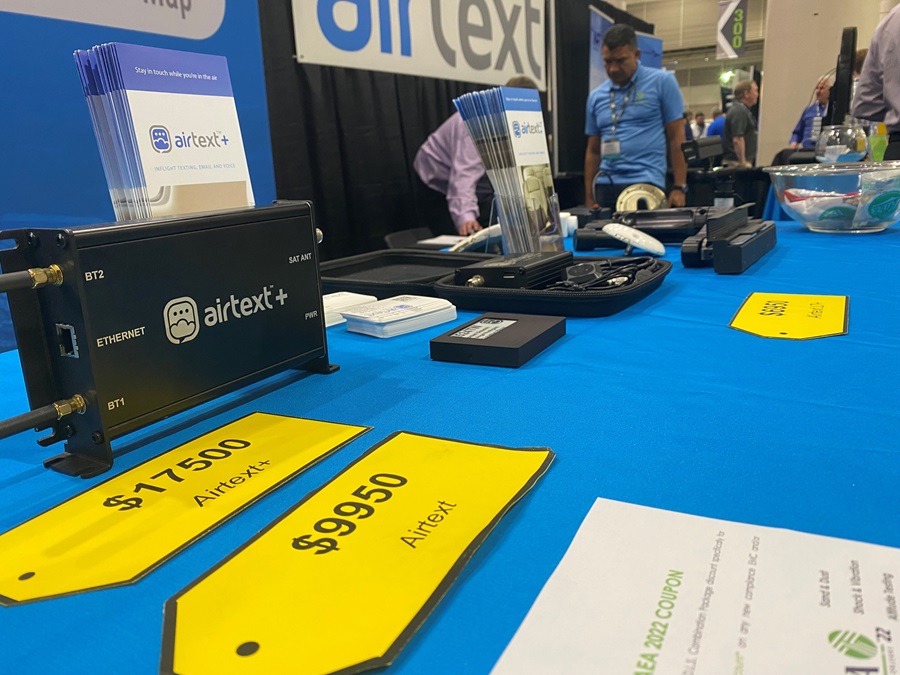Reasonable retrofits, connectivity
Lower-priced products that caught our eye at AEA
While many of the products showcased on the exhibit floor at the Aircraft Electronics Association International Convention and Trade Show in New Orleans were designed for turbine aircraft, a quick tour uncovered a few products made for single-engine pistons of a certain age.
The lineup of new product rollouts was a bit less populated this year, compared to past AEA conventions, with 29 companies taking part in the rapid-fire pitch session that opened the show March 28.
Lined up third in the batting order, a much less expensive solution from Airtext, a Georgia-based company founded seven years ago by aviation entrepreneur and CEO David Gray. He started beefing up his parts inventory 14 months ago anticipating supply chain trouble, and he came to the annual avionics industry trade show ready to ship orders the same day on a range of devices that deliver satellite-based communication capabilities. Prices start at $4,950 for a portable unit that allows multiple users to send text messages wirelessly from a remote lakeside fishing camp or aboard any general aviation aircraft.
Gray said he “wasn’t smart enough to retire” after selling his last business and began working on products that enable pay-as-you transmit satellite messaging. “My customers asked for a low-cost way to have connectivity.”
Gray held a compact device in his hands as he detailed the capability of the portable LT version that connects to the Iridium satellite network (data plans start at $400 a year, with text messages billed at 5 cents each) from anywhere.
"This is a $5,000 box that allows everybody on board the airplane to be able to text and receive messages," Gray said.
The device becomes a Bluetooth hotspot serving multiple users at once, and Gray said many users who reserve their texting for urgent messages pay little more than the $400 Iridium data plan, while the most frequent communicators wind up with a bill of around $2,500, still a fraction of competing options.
For prices ranging from $9,950 to $17,500, versions approved by the FAA for installation in aircraft starting with light piston twins up to large business jets can provide voice and email capability via the same Iridium network, with voice calls billed at $1.25 per minute.
 Trig Avionics had hoped to join the new product announcement lineup, though Jon Roper, marketing manager for the company based in Scotland, said the certification process for the final piece of its low-profile radio stack retrofit, the TX56A nav/com radio, was still ongoing. He attributed the two-year delay to a combination of technical issues that came to light late in the certification process, and the coronavirus pandemic. Trig has produced a range of avionics products for experimental and homebuilt aircraft, as well as Part 23 aircraft equipped with aging analog radios. The compact, intuitive TX56A has many features unheard-of when airplanes were delivered with analog radios, including USB programmability and one-button playback of up to 30 seconds of radio transmissions, all contained in a box measuring 1.3 inches tall, with no cooling fans required.
Trig Avionics had hoped to join the new product announcement lineup, though Jon Roper, marketing manager for the company based in Scotland, said the certification process for the final piece of its low-profile radio stack retrofit, the TX56A nav/com radio, was still ongoing. He attributed the two-year delay to a combination of technical issues that came to light late in the certification process, and the coronavirus pandemic. Trig has produced a range of avionics products for experimental and homebuilt aircraft, as well as Part 23 aircraft equipped with aging analog radios. The compact, intuitive TX56A has many features unheard-of when airplanes were delivered with analog radios, including USB programmability and one-button playback of up to 30 seconds of radio transmissions, all contained in a box measuring 1.3 inches tall, with no cooling fans required.
The TX56A (10 watts, $4,090) and TX57A (16 watts, $4,997) both feature an LCD screen that can display a course deviation indicator as a backup for that instrument, and will complete the stack that also includes an audio panel and transponder. Trig supplies preconnected wiring harnesses to reduce the labor required for installation.
Mid-Continent Instruments and Avionics announced that the Flex Custom Function Display rolled out in 2021 as a blank canvas for shops seeking to build instruments to replace installed units that are obsolete and unavailable has been expanded to include five new instruments that are installation-ready, in the same 2-inch form factor that many older-model light jets and turboprops require. With prices ranging from $2,500 to $5,500, the Flex digital instrument line includes a counter drum encoding altimeter, airspeed indicator, GPS clock, and battery monitor, with an attitude indicator to follow in the fourth quarter (the pricing for that is yet to be announced).
Designed for Part 23 aircraft starting at 6,000 pounds and some Part 25 aircraft, the new Flex instruments cost about half as much as replacing a mechanical gauge of the same size, with dramatically enhanced capabilities, according to Matthew Harrah, who demonstrated the various functions at the Mid-Continent booth. The company also rolled out a few wireless charging options to keep mobile devices topped off in flight.
The last company to present during the new product session on March 28, ACR Electronics, announced new emergency locator transmitter solutions made for business jets: the ELT 4000S that runs on alkaline batteries (eliminating the hazardous material shipping and onboard fire containment required for lithium battery ELTs), and the crash-hardened ELT 5000 DT.
Around the corner, the ELT 345 caught the eye of a piston pilot interested in 406 MHz ELT options for smaller aircraft and available at a lower cost, and this one is available in three models ranging in price from $600 to $800.














